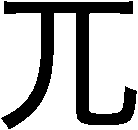JapanPi
JapanPi is set of the following Unicode characters:
These characters have similar graphical representation[5] and, perhaps, similar pronunciations "kotsu" (in Japanese) and similar meaning, referring to something, lofty, bald, dangerous.
Ethymology
Name JapanPi is chosen for the following reasons:
1. Characters similar to JapanPi are used in Japanese.
(Among the JapanPi, in Japanese language, the X5140 兀
seems to be most usual.)
2. These characters look similar to the Greek letter \(\pi\). If some of characters of JapanPi appears in a math formula, it is definitely interpreted as the Greek letter "pi".
At combining of two words to the single term, the second word is capitalized in order to simplify the visual separation of the term to the two parts.
Note, that the Greek letters \(\pi\), \(\mathrm \pi\),
X03C0 π [6]
X03D6 ϖ [7] (partially supported at Macintosh),
X1D6D1 𝛑 [8], supported at Macintosh
..
that gave hint to name of set JapanPi, are not used in Japanese language.
So, by the definition in the preamble, these Greek letters are not included into set JapanPi.
However, these Greek letters are also very difficult;
not only humans, but also the software confuse them. The confusions with Greek letters may be described separately in Future (as soon as the Editor meets the need to deal with the Greek symbols outside of math formulas), but they fall out from the scope of this article.
Graphic
Pictures of characters JapanPi depend on the software used. Up to year 2021, yet, no standard for the representations in computers is established.
At your computer, these characters look in this way (enlarged):
⺎
兀
兀
At Macintosh, they look this way:
At Linux, they look this way:
Phonetic and semantic
Among the JapanPi, the X5140 兀 seems to be more usual, more popular; it is widely presented in the atrticles available in the free access at the Internet.
Descriptions of phonetic and semantic properties of X5140 兀 seem to apply to all characters of KanjiPi.
In particular, these characters may be pronounced as コツ and refer to somethint high, lofty, bald, dangerous.
References
- ↑ https://jisho.org/search/%E5%85%80%20%23kanji https://jisho.org/search/兀%20%23kanji 兀 3 strokes Radical: legs 儿 Parts: 一 儿 high & level, lofty, bald, dangerous On: コツ Words starting with 兀 Words ending with 兀 Words containing 兀 External links Stroke order On reading compounds 兀然 【コツゼン】 towering, standing motionlessly, still 兀立 【コツリツ】 towering, standing motionlessly 突兀 【トッコツ】 lofty, soaring, towering, precipitous, high and steep, sharply sticking out, jutting upward
- ↑ https://util.unicode.org/UnicodeJsps/character.jsp?a=2E8E ⺎ 2E8E CJK RADICAL LAME ONE Han Script id: allowed confuse: 兀 , 兀
- ↑ https://util.unicode.org/UnicodeJsps/character.jsp?a=5140 兀 5140 CJK UNIFIED IDEOGRAPH-5140 Han Script id: restricted confuse: 兀 , ⺎
- ↑ https://util.unicode.org/UnicodeJsps/character.jsp?a=FA0C 兀 FA0C CJK COMPATIBILITY IDEOGRAPH-FA0C Han Script id: allowed confuse: 兀 , ⺎ ..
- ↑
https://en.wiktionary.org/wiki/%E5%85%80
https://en.wiktionary.org/wiki/兀 .. Japanese Kanji See also: Category:Japanese terms spelled with 兀 兀 (uncommon “Hyōgai” kanji) bald become baldReadings On (unclassified): こつ (kotsu); ごつ (gotsu) Kun: たかい (takai, 兀い); はげる (hageru); あしきる (ashikiru) Nanori: たかし (takashi) .. - ↑ https://util.unicode.org/UnicodeJsps/character.jsp?a=03c0 π 03C0 GREEK SMALL LETTER PI Greek Script id: restricted confuse: 𝞏 , 𝛑 , ᴨ , 𝝅 , 𝜋 , 𝟉 , 𝝿 , ϖ , 𝛡 , 𝝕 , ℼ , 𝜛 , 𝞹 , п
- ↑ https://util.unicode.org/UnicodeJsps/character.jsp?a=03d6 ϖ 03D6 GREEK PI SYMBOL Greek Script id: allowed confuse: π , 𝞏 , 𝛑 , ᴨ , 𝝅 , 𝜋 , 𝟉 , 𝝿 , 𝛡 , 𝝕 , ℼ , 𝜛 , 𝞹 , п
- ↑ https://util.unicode.org/UnicodeJsps/character.jsp?a=1d6d1 𝛑 1D6D1 MATHEMATICAL BOLD SMALL PI Lowercase Letter id: allowed confuse: π , 𝞏 , ᴨ , 𝝅 , 𝜋 , 𝟉 , 𝝿 , ϖ , 𝛡 , 𝝕 , ℼ , 𝜛 , 𝞹 , п ..
Keywords
Confusion, Japanese, Kanji, KanjiConfudal, KanjiLiberal, KanjiRadical, Unicode, X5140 兀 , X2E8E ⺎ , XFA0C 兀
